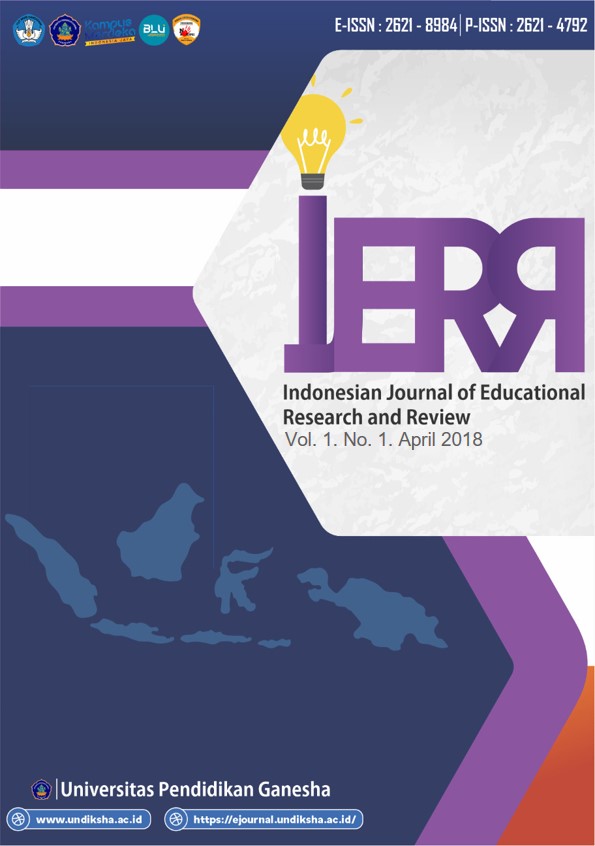PENGARUH MODEL ATI BERBANTUAN MEDIA AUDIO VISUAL TERHADAP HASIL BELAJAR IPA SISWA KELAS V SD
DOI:
https://doi.org/10.23887/ijerr.v1i1.14623Abstract
This study used quasi experiment research through post test which only used control group design. This study tried to experiment Aptitude Treatment Interaction (ATI) model assisted audio visual media aimed to know the effect on science learning outcomes in grade V elementary students in Group IV Cempaka Putih Kecamatan Kubutambahan. The population of this study were the entire students of grade V in group IV Cempaka Putih, which amount to 168 students. The sample of this research were class V SDN 2 and 3 Bulian with the number of each students were 25 and 2, which was determined by random sampling technique. The data were analyzed by descriptive statistic and Independent Sample t-test. The results showed that the value of t count of 2.025 and ttab of 2.00. It meant that there was a significant effect of science learning outcomes between groups of students who were taught by ATI model assisted audio visual media and groups of students who were taught by non-ATI assisted by audio visual media.References
BSNP. 2006. Panduan Penyusunan Kurikulum Tingkat Satuan Pendidikan Jenjang Pendidikan Dasar dan Menengah. Jakarta: Pusat Kurikulum.
Daryanto. 2016. Media Pembelajaran. Yogyakarta: Penerbit Gava Media.
Daryanto. 2016. Media Pembelajaran. Yogyakarta: Penerbit Gava Media.
Jayanto, Dw. Nym. R. Dwi. 2013. “Pengaruh Pembelajaran ATI (Aptitude Treatment Interaction) Terhadap Hasil Belajar IPA Siswa Kelas IV Semester II di SD Kelurahan Banyuning”. Tersedia pada: https://ejournal.undiksha.ac.id/index.php/JJPGSD/article/view/1453/1314 (diakses pada: 3 Januari 2018)
Partimi, Ni Pt Irma. 2013. “Pengaruh Metode Bermain Peran Berbantuan Media Audio Visual Terhadap Hasil Belajar IPS Siswa Kelas IV SDN 1 Seririt”. Tersedia pada: https://ejournal.undiksha.ac.id/index.php/JJPGSD/article/view/821/694 (dikses pada: 23 April 2018)
Putra, A.A. Ngurah Mahendra. 2013. “Pengaruh Model Pembelajaran ATI (Aptitude Treatment Interaction) Berbantuan Peta Konsep Terhadap Hasil Belajar IPA”. Tersedia pada: https://ejournal.undiksha.ac.id/index.php (diakses pada: 3 Januari 2018)
Sisdiknas. 2006. Undang-Undang Republik Indonesia Nomor 20 Tahun 2003 SISDIKNAS Sistem Pendidikan Nasional. Bandung: Fokusmedia.
Sulastriningsih, Pt. 2012. “Pengaruh Model Process Oriented Guided Inquiry Learning Terhadap Kemampuan Pemahaman Konsep IPA Siswa Kelas V SD Gugus XI Kecamatan Buleleng”. Tersedia pada: https://ejournal.undiksha.ac.id/index.php/JJPGSD/article/viewFile/820/693 (diakses pada: 2 Januari 2018).
Suryanata, I Gd. 2013. “Pengaruh Model Pembelajaran Synectics Berbantuan Media Audio Visual Terhadap Hasil Belajar IPS Kelas V Sd Gugus Ii Kecamatan Karangasem”. Tersedia pada: https://ejournal.undiksha.ac.id/index.php/JJPGSD/article/view/1049/914 (diakses pada: 23 April 2018).
Trianto. 2012. Model Pembelajaran Terpadu. Jakarta: Prestasi Pustaka Publisher.
Widyastuthi, Ni Luh Oktalia. 2013. “Pengaruh Model Pembelajaran ATI (Aptitude Treatment Interaction) Terhadap Hasil Belajar IPA Kelas V SD Negeri 1 Melaya”. Tersedia pada: https://ejournal.undiksha.ac.id/index.php/J JPGSD/article/view/829/702 (diakses pada: 3 Januari 2018).
Downloads
Published
How to Cite
Issue
Section
License
Authors who publish with the Indonesian Journal of Educational Research and Review (IJERR) agree to the following terms:
- Authors retain copyright and grant the journal the right of first publication with the work simultaneously licensed under a Creative Commons Attribution-ShareAlike 4.0 International License. that allows others to share the work with an acknowledgment of the work's authorship and initial publication in this journal.
- Authors are able to enter into separate, additional contractual arrangements for the non-exclusive distribution of the journal's published version of the work (e.g., post it to an institutional repository or publish it in a book), with an acknowledgment of its initial publication in this journal.
- Authors are permitted and encouraged to post their work online (e.g., in institutional repositories or on their website) prior to and during the submission process, as it can lead to productive exchanges, as well as earlier and greater citation of published work. (See The Effect of Open Access)









